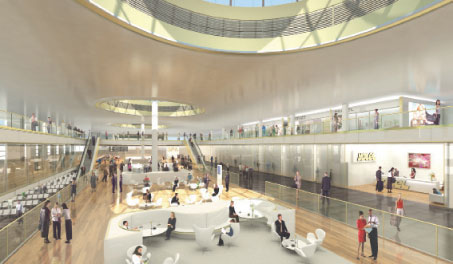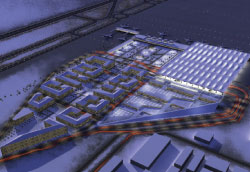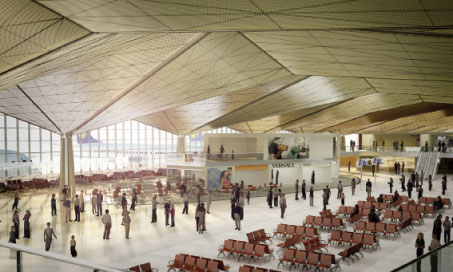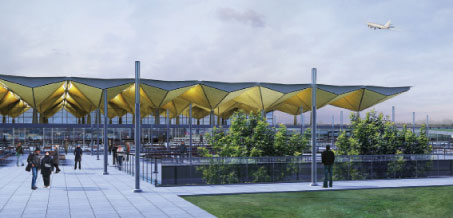
Middleton: “We studied the city of St Petersburg very carefully and tried to respond to the local climate as much as possible. We designed a flat roof, with thin roof lights and reflectors to guild the light.’’
Pulkovo Airport handled in excess of seven million passengers in 2008, split equally between international and domestic traffic, representing a 15% year-on-year increase. At present, there is not sufficient terminal capacity during peak times. In accordance with traffic forecasts, Pulkovo Airport is likely to process more than 17.3 million passengers by 2025 and has the potential to reach 40 million passengers by 2039.
It is against this background that the existing terminal configuration is constraining potential for long-term growth. This is due to a lack of physical connection between Terminals 1 and 2, where Pulkovo 1 serves domestic flights some 6km apart from the international terminal, Pulkovo 2.

Grimshaw and partners have also won the competition to develop an urban plan for an airport city.
A new combined international and domestic terminal is now under construction in the midfield between the two independent runways. The development will involve integrating the existing Pulkovo 1 into the new terminal complex, so that sufficient facilities for all domestic and international operations can be accessed under the one roof, enabling centralised access. The existing international terminal is expected to become a private airport.
“Having the split operations in two terminals is proving to be inefficient. Nowadays, both existing Pulkovo terminals are not able to accommodate the increasing demands in aviation security and handling procedures due to its outdated design. In addition, the current apron layout provides only 47 operational aircraft stands versus 100 stands that are required for future operations. Terminal capacity is limited by having 43 registration desks in both terminals versus the 98 required,” explained Viktor Konyashchenkov, Pulkovo’s deputy director.
Building a centralised terminal in the midfield will enable Pulkovo to provide both aircraft and passengers with efficient and quality services, he added. The tender is now open for a 30-year concession to operate the new terminal until 2039.
Modern technology services will be implemented in the new terminal to help facilitate forecasted growth. “Our objective is to have the passenger terminal equipped with intelligent facilities. As part of the technical documentation, we will provide the pre-qualified investors with the minimal technical requirements for all airport systems, including security and information systems, baggage systems, check-in counters and contact stands,” said Konyashchenkov.

Building a centralised terminal in the midfield will enable Pulkovo to provide both aircraft and passengers with efficient and quality services.
As the only international airport in northwest Russia, St Petersburg-Pulkovo is vying to position itself as an international hub by 2025, capable of competing with the Moscow airports. “Pulkovo Airport is the gateway to St Petersburg, which is the most European city in Russia. During the next few years our main goal is to become the most convenient entry point for Russian passengers to Europe and for European guests to Russia,” said Konyashchenkov.
Representing St Petersburg’s heritage and future
In February 2007, the City of St Petersburg and Pulkovo Airport called for an international architectural competition to design the new terminal and airport plaza, which was won by Grimshaw Architects. “The city’s heritage and its future have come together in the design of the new terminal project and Grimshaw’s uniquely designed roof is inspired by St Petersburg’s historical architecture. We believe that Grimshaw’s terminal building will not only become a new St Petersburg landmark, but also a comfortable and functional facility,” said Konyashchenkov.
NACO BV (Netherlands Airport Consultants) provided specialist expertise with the functionality of the terminal, civil engineering and the landside commercial area. Martin Hill, NACO’s manager of architectural engineering and planning, said: “Terminal functionality is a crucial element in promoting a positive passenger experience and functional aspects have been given high priority in the design process.”
As a newcomer to Russia, the Grimshaw team was able to capture and portray the spirit of the city within the designs. Mark Middleton is a partner at Grimshaw Architects and has headed the Pulkovo Airport project. As Middleton explained, the new roof and envelope has been designed with sustainability in mind, to provide the greatest protection from extreme snowfall in winter and to make the best use of low natural light. “We studied the city of St Petersburg very carefully and tried to respond to the local climate as much as possible. We designed a flat roof, with thin roof lights and reflectors to guild the light,” he said.
The internal layout of the new terminal consists of well-defined zones, connected by individual walkways that resemble the city’s layout of islands and bridges. The cultural influence is strengthened by a sculpture-lined boulevard, which forms the airport gateway and is reminiscent of St Petersburg’s Grand Avenue.

Hill: “Terminal functionality is a crucial element in promoting a positive passenger experience and functional aspects have been given high priority in the design process.”
Strategy for hub status by 2020
“Our priority is to attract new airlines that are able to operate regular long-haul flights to St Petersburg from Japan, the US, Asia Pacific and the Middle East,” said Konyashchenkov.
The opening of the new terminal will lift the airport’s reputation considerably on an international level, explained Middleton. “The development is a quantum leap and could easily hold its own among the world’s top airports. I think the future for St Petersburg is bright; Pulkovo could take some of the business away from Helsinki, as a big hub, as well as traffic from Asia.”
NACO agrees that the new terminal will prove crucial to Pulkovo’s long-term strategy to grow its global routes. “Improving the airport’s infrastructure and providing a higher level of services will make it possible for Pulkovo to become a new gateway to Russia, making it more attractive to airlines. It will set the conditions for St Petersburg to expand its international aviation network,” said Hill.
The final retail and F&B concept design details will be a task assigned to the winning investor consortium – but preliminary estimates for the terminal’s commercial space have settled at 14,500sqm. Currently, Pulkovo Airport’s non-aviation revenue does not exceed 15-20%. “In the existing terminals, we are limited on commercial space. I think that there will be many more commercial opportunities when the new terminal is fully operational and we hope to boost commercial activity up to 50% of the total revenue,” said Konyashchenkov.







